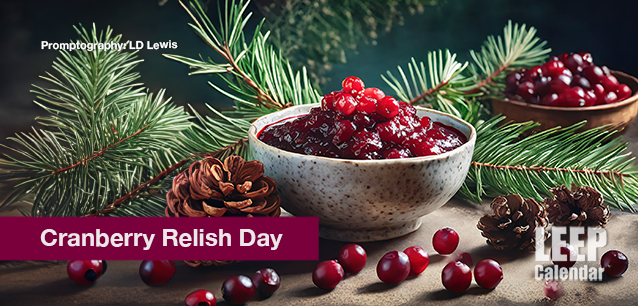 AD
AD
Today is: August 09
Scroll to explore events active on this date.
Additional Events on LEEP
LEEP INK FEATURES

August? Absolutely!
In August, we live through the Dog Days of Summer. It's hot and often humid, and those who can leave for better climates do. Down south, winter is in full force. August is also known as "the ...

In The Heat of July: July 2025 Events
Is it hot enough (or cold enough if you're below the equator) for you yet? There is actually a day for that! Like every month, I pick a diverse collection of events you may or may not know about. This ...

May Blooms: Events in May 2025
Along with October, May is one of the most densely packed months of the year. It's before the summer humidity and the last whole month of the school year. The weather is warming in t...
About Cranberry Relish Day
Ends: Nov 22, 2025
DESCRIPTION:
Cranberry Relish Day celebrates the iconic Thanksgiving side dish.
Cranberry relish on the East Coast and sauce on the West Coast is a staple on many Thanksgiving tables in the United States. Its history intertwines with the story of cranberries and its significance in American culture and cuisine. The cranberry, blueberries, and blackberries are the three fruits native to North America. This tart and sweet condiment, made primarily from cranberries, often combined with sugar and other fruits, is rooted in Native American traditions.
Native Americans used cranberries as a food source, for medicinal purposes, and as a dye. They also taught early European settlers how to use cranberries for sustenance. Native Americans crushed cranberries and mixed them with other fruits, such as blueberries or concord grapes, and sometimes with nuts or honey. This mixture was known as pemmican, a nutritious and long-lasting food essential for winter survival.
European settlers in North America adopted cranberries into their diets, and by the 17th century, they were cooking cranberries with sugar for a sweet-tart sauce to accompany meats. Cranberry sauce at early Thanksgiving feasts is undocumented, but by the 18th century, it had become a common accompaniment to meals in the region.
The commercialization of cranberries in the 19th and 20th centuries played a significant role in popularizing cranberry relish. In 1816, Henry Hall, a Revolutionary War veteran, cultivated cranberries in Cape Cod, marking the beginning of cranberry farming—the development of the cranberry bog system allowed for larger-scale production and distribution.
Cranberry sauce and relish gained popularity as a Thanksgiving side dish in the 20th century, especially with Ocean Spray, a grower-owned cooperative's 1912 introduction of canned cranberry sauce. This innovation made cranberries more accessible to American households, solidifying their place in the Thanksgiving tradition.
Today, cranberry relish remains a holiday favorite, with recipes ranging from simple, traditional versions to more complex ones featuring ingredients like oranges, nuts, and spices. Its tartness and bright flavor complement the richness of Thanksgiving dishes and embody the history and culinary traditions of the United States.
VIDEOS
SUPPORTING DOCUMENTS
Currently, this event does not have supporting documents.
ADDITIONAL IMAGES
Currently, this event does not have supporting images.
Where would you like to go now?
 AD
AD


/footer-logo.svg)
